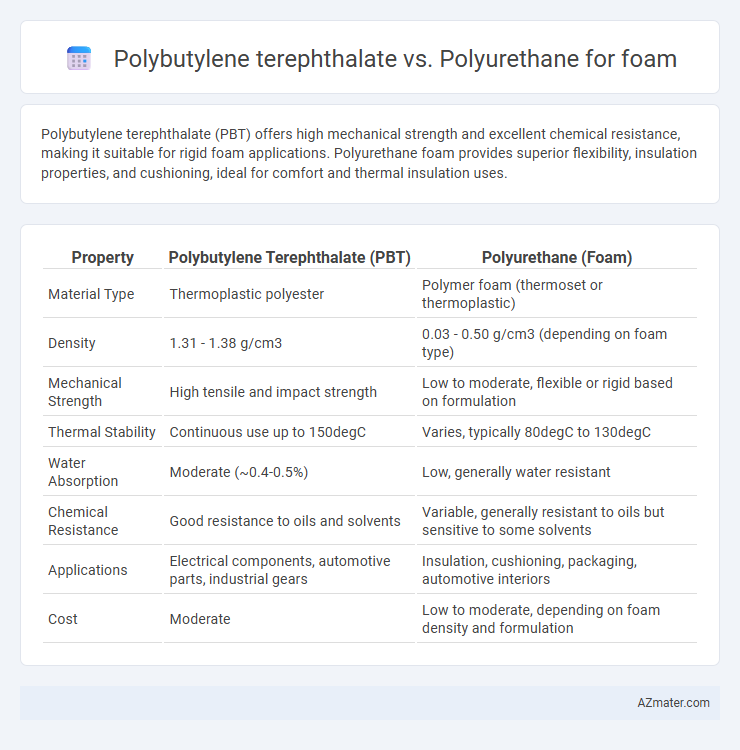Polybutylene terephthalate (PBT) offers high mechanical strength and excellent chemical resistance, making it suitable for rigid foam applications. Polyurethane foam provides superior flexibility, insulation properties, and cushioning, ideal for comfort and thermal insulation uses.
Table of Comparison
| Property | Polybutylene Terephthalate (PBT) | Polyurethane (Foam) |
|---|---|---|
| Material Type | Thermoplastic polyester | Polymer foam (thermoset or thermoplastic) |
| Density | 1.31 - 1.38 g/cm3 | 0.03 - 0.50 g/cm3 (depending on foam type) |
| Mechanical Strength | High tensile and impact strength | Low to moderate, flexible or rigid based on formulation |
| Thermal Stability | Continuous use up to 150degC | Varies, typically 80degC to 130degC |
| Water Absorption | Moderate (~0.4-0.5%) | Low, generally water resistant |
| Chemical Resistance | Good resistance to oils and solvents | Variable, generally resistant to oils but sensitive to some solvents |
| Applications | Electrical components, automotive parts, industrial gears | Insulation, cushioning, packaging, automotive interiors |
| Cost | Moderate | Low to moderate, depending on foam density and formulation |
Introduction to Polybutylene Terephthalate and Polyurethane
Polybutylene terephthalate (PBT) is a thermoplastic polymer known for its high mechanical strength, excellent electrical properties, and chemical resistance, making it suitable for engineering applications including automotive and electronics. Polyurethane (PU) is a versatile polymer commonly used in foam applications, valued for its flexibility, durability, and cushioning properties, widely applied in furniture, insulation, and footwear. While PBT offers rigidity and thermal stability, polyurethane foam excels in lightweight comfort and impact absorption, defining their distinct roles in material selection.
Chemical Structure and Composition
Polybutylene terephthalate (PBT) is a semi-crystalline thermoplastic polyester composed of repeating units of terephthalic acid and 1,4-butanediol, providing high mechanical strength and thermal stability ideal for foam applications requiring rigidity. Polyurethane (PU) foam consists of soft polymer chains formed by the reaction of diisocyanates with polyols, resulting in a versatile cellular structure with excellent flexibility and cushioning properties. The chemical structure of PBT yields a dense, durable foam matrix, while polyurethane's urethane linkages allow for tailored cross-linking density and foam softness.
Manufacturing Processes for PBT and PU Foam
Polybutylene terephthalate (PBT) is typically processed through injection molding, extrusion, and compression molding, leveraging its semi-crystalline thermoplastic properties to achieve high dimensional stability and mechanical strength in foam applications. Polyurethane foam manufacturing involves a chemical reaction between diisocyanates and polyols, resulting in a versatile open-cell or closed-cell foam structure tailored through reaction injection molding, slab stock, or spray foam techniques. The manufacturing process of PBT foam focuses on thermal and mechanical shaping, while PU foam relies on controlled polymerization and foaming reactions to achieve its flexibility and cushioning characteristics.
Mechanical Properties Comparison
Polybutylene terephthalate (PBT) foam exhibits higher tensile strength and superior dimensional stability compared to polyurethane (PU) foam, making it ideal for applications requiring rigidity and durability. PBT offers better chemical resistance and thermal stability, maintaining mechanical integrity under high-temperature conditions where polyurethane foams may soften or degrade. Polyurethane foams, however, provide enhanced flexibility and cushioning due to their lower density and higher elongation at break, offering better shock absorption in impact-sensitive uses.
Thermal Stability and Heat Resistance
Polybutylene terephthalate (PBT) exhibits superior thermal stability and heat resistance compared to polyurethane foams, maintaining structural integrity at temperatures up to 150degC, while polyurethane typically withstands temperatures only up to 80-100degC. PBT's crystalline structure contributes to its enhanced thermal performance, making it ideal for applications requiring long-term exposure to elevated temperatures. Polyurethane foam, although flexible and lightweight, degrades faster under thermal stress, limiting its use in high-heat environments.
Flexibility and Cushioning Performance
Polybutylene terephthalate (PBT) foam offers moderate flexibility with excellent dimensional stability and resistance to deformation under compressive stress, making it ideal for applications requiring consistent cushioning performance over time. Polyurethane foam surpasses PBT in flexibility due to its open-cell structure, providing superior energy absorption and cushioning with enhanced softness and rebound characteristics. The choice between PBT and polyurethane foam depends on the required balance of mechanical resilience and cushioning comfort in specific applications such as automotive seating or sports equipment.
Durability and Lifespan
Polybutylene terephthalate (PBT) displays superior chemical resistance and dimensional stability, contributing to enhanced durability and a longer lifespan in foam applications exposed to harsh environments. Polyurethane foam offers excellent flexibility and cushioning but tends to degrade faster under UV exposure and chemical contact, reducing its usable lifespan. For applications demanding extended durability and resistance to environmental stressors, PBT-based foams are often the preferred choice.
Environmental Impact and Recyclability
Polybutylene terephthalate (PBT) foam offers superior recyclability due to its thermoplastic nature, enabling multiple recycling cycles with minimal degradation. Polyurethane (PU) foam, often thermoset, poses environmental challenges because it is less recyclable and typically ends up in landfills, contributing to long-term waste. PBT's lower carbon footprint and potential for chemical recycling make it a more sustainable choice compared to the energy-intensive production and disposal issues associated with PU foam.
Common Applications in Industry
Polybutylene terephthalate (PBT) is widely utilized in automotive and electronics industries for its excellent dimensional stability, electrical insulation, and chemical resistance, making it ideal for housing foam components. Polyurethane foam finds extensive applications in furniture, insulation, and cushioning due to its flexibility, durability, and excellent impact absorption properties. Both materials are chosen based on specific performance requirements, with PBT favored for precision structural parts and polyurethane preferred for energy absorption and comfort-based uses.
Choosing the Right Material: Key Considerations
Polybutylene terephthalate (PBT) offers excellent dimensional stability, chemical resistance, and thermal properties, making it suitable for high-performance foam applications requiring durability and precision. Polyurethane foam excels in flexibility, cushioning, and shock absorption, ideal for applications needing comfort and elasticity. Choosing between PBT and polyurethane foam depends on factors like mechanical strength, environmental exposure, temperature resistance, and end-use requirements.

Infographic: Polybutylene terephthalate vs Polyurethane for Foam
 azmater.com
azmater.com